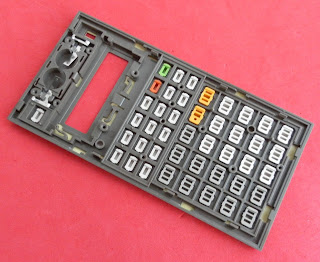Canon F-73P Scientific Statistical Calculator
This unit was made after May of 1984, according to the processor date code.72 pages user manual, printed in Japan, 1983.
Handy little pocket calculator, CASIO style, with a useful set of features and a basic blind programming capability.
It has six operation modes: Decimal, Hexadecimal, Octal, 1-Var Stats, 2-var Stats, Program 1, Program 2.
Display mode supports Floating, Scientific and Engineering. Fix 0 to 7 digits.
One independent memory register, six storage registers.
Programming:
45 program steps.
5 control instructions (Halt, Enter data, relative unconditional jump GoTo and two relative conditional jumps)
Calculator forensics test: 9.0000278593
Display mantissa digits: 10 digits
Internal mantissa digits: 11 digits
Getting the extra internal digit: (result - 9) * 1000000
Slim body with 70mm x 137mm x 8mm and just 75g weight.
Power supply: 3VDC 0.36mW (120µA nominal) from 2 x G13/LR44 1.5V battery cells.
Expected battery life: 4000 hours for G13 silver oxide, 1500 hours for LR44 alkaline.
Besides the hardware Power On/Off switch, this calculator features software Power Off and Power On functions along with inactivity Auto Power Off.
The hardware Power OFF switch wipes all the memory data.
However, the software OFF key will turn off the LCD display and put the processor in deep sleep mode while preserving all the memory contents. This is very well implemented in the Toshiba T6711 processor with less than 0.05µA of current consumption.
Current consumption measurements:
Power On idling: 30µA avg
Power On calculate 69!: 92µA avg
Power On running a looping program: 94µA avg
Soft Power Off: less than 0.05µA
Tear down.
Excellent quality stainless steel screws, hard to find these days on this kind of equipment.
Very well designed battery compartment.
The PCB is maintained in place by nine screws and eight lateral plastic latches.
To remove the PCB, it must be lifted from the lower keyboard side in first place, requiring gentle force on the plastic latches.
The LCD display is glued on the sides of the zebra strip connector and probably will come attached to the PCB. Cleaning the contacts is recommended to get a better LCD contrast.
The membrane keyboard is easily taken apart to be washed in warm water using dish washing detergent along with the plastic keys and case front panel and back cover.
LCD display, probably from EPSON.
SoC CMOS processor from Toshiba T6711 date code 4.E (1984, May).
























